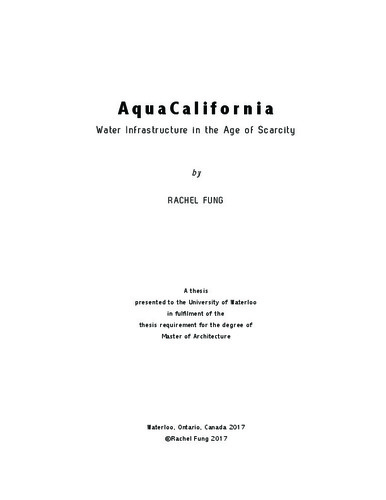UWSpace will be migrating to a new version of its software from July 29th to August 1st. UWSpace will be offline for all UW community members during this time.
AquaCalifornia: Water Infrastructure in the Age of Scarcity
| dc.contributor.author | Fung, Rachel | |
| dc.date.accessioned | 2017-04-26 19:25:52 (GMT) | |
| dc.date.available | 2017-04-26 19:25:52 (GMT) | |
| dc.date.issued | 2017-04-26 | |
| dc.date.submitted | 2017 | |
| dc.identifier.uri | http://hdl.handle.net/10012/11754 | |
| dc.description.abstract | Water scarcity has always been a defining issue of the American West; and California is one of the western states that have long struggled with the management of its water resources. Over the past 5 years, California’s water system was confronted with one of its biggest challenges, the state’s worst drought in 1200 years. A series of natural phenomenon triggered by climate change have caused significant depletion in the regional freshwater supply, leading to the closure of many agribusinesses and a decrease in employment and food supplies. In California, water scarcity is not only an environmental crisis but also affects economic, political and social systems on multiple levels. In addition to climate instability, outdated water infrastructure systems and failure to capture potential water resources are also key contributors to California’s water scarcity. Currently, much of the Golden State is highly dependent on imported water supplies from distant regions. Under the existing drought however, these large-scale water allocation systems are proven to be unreliable as they further unbalance water stress at the source and end-use locations. Locally, a lack of public interest and effective water infrastructures also hindered the capture of stormwater and recycling of wastewater. Many cities in the state fail to capitalize these potential water savings and simply direct them into disposal systems; such contamination and waste of runoff represented a valuable but missed opportunity to offset the drought impacts. The goal of this thesis is to develop a series of decentralized water systems that could focus on capitalizing alternative water resources in Californian cities, and simultaneously function as public spaces for additional programs in urban areas. This speculative proposal would not only serve as a prototype for future urban developments, but encourage planners and builders to reimagine the urban fabric as part of the larger hydrological system. It also helps reinvent modern water infrastructures to better facilitate urban life and actively engage the public in order to create the necessary paradigm shift in water consumption culture. As dry conditions become the “new-normal” of the American West, designers must become more engaged in the sustainability movement and help renegotiate the relationship between the urban fabric and its water infrastructure. Through the assessment and redesign of the current water network, AquaCalifornia proposes a new direction of water infrastructure development for a more potent and reliable water future in California. | en |
| dc.language.iso | en | en |
| dc.publisher | University of Waterloo | en |
| dc.subject | water | en |
| dc.subject | California | en |
| dc.subject | water infrastructure | en |
| dc.subject | drought | en |
| dc.subject | water scarcity | en |
| dc.subject | resources | en |
| dc.subject | aquacalifornia | en |
| dc.subject | architecture | en |
| dc.subject | urbanism | en |
| dc.subject | American West | en |
| dc.title | AquaCalifornia: Water Infrastructure in the Age of Scarcity | en |
| dc.type | Master Thesis | en |
| dc.pending | false | |
| uws-etd.degree.department | School of Architecture | en |
| uws-etd.degree.discipline | Architecture | en |
| uws-etd.degree.grantor | University of Waterloo | en |
| uws-etd.degree | Master of Architecture | en |
| uws.contributor.advisor | El Khafif, Mona | |
| uws.contributor.advisor | Sheppard, Lola | |
| uws.contributor.affiliation1 | Faculty of Engineering | en |
| uws.published.city | Waterloo | en |
| uws.published.country | Canada | en |
| uws.published.province | Ontario | en |
| uws.typeOfResource | Text | en |
| uws.peerReviewStatus | Unreviewed | en |
| uws.scholarLevel | Graduate | en |

